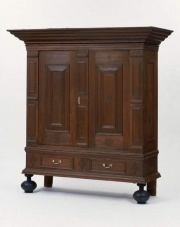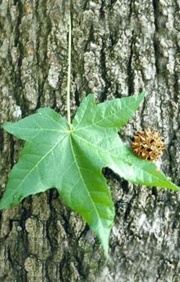Difference between revisions of "Liquidambar"
JMcGlinchey (talk | contribs) |
|||
| Line 18: | Line 18: | ||
Heartwood contains dark streaks with tangential and radial cuts. | Heartwood contains dark streaks with tangential and radial cuts. | ||
| + | |||
| + | Paper fiber type: hardwood, diffuse porous. Using transmitted light microscopy, pulp is identified by numerous very long vessels with minimal scalariform or opposite pitting. Perforations are scalariform with 15-25 thin, branched bars.Tails of vessels have spirals. Fiber tracheids are common. Appearance with [[Graff "C" stain]]: dark blue, but varies with bleaching. Average dimensions of fibers: length 1.7mm, 20-40μm wide. Common pulping method: [[kraft process|kraft]]. | ||
== Hazards and Safety == | == Hazards and Safety == | ||
Revision as of 14:37, 15 July 2015
Description
Any of several deciduous trees of the genus Liquidambar, such as the American sweetgum (Liquidambar styraciflua) and the Oriental sweetgum (Liquidambar orientalis). Liquidamber trees are primarily ornamental producing bright red leaves in the fall. The reddish-brown heartwood from the liquidamber trees is sold as red gum wood. It is valued for furniture and small decorative items. The resin from liquidambar trees (storax) has been used in perfumes and embalming.
Synonyms and Related Terms
liquidamber (sp); American sweetgum (Liquidambar styraciflua); Oriental sweetgum (Liquidambar orientalis); copalme d'Amérique (Fr.); liquidambar (Fr., It.); storax; gum wood; sweet gum; red gum; satin walnut
Other Properties
Medium tree growing to 25 m with straight trunk and pyramidal crown. Bark=gray-brown with irregular furrows and rounded ridges. Leaves=star-like with palmate veins and 5 to 7 lobes (10-15 cm) Fruit=spiny gumballs containing 2 seeds, maturing in fall.
Wood has small pores. Indistinct growth rings.
Heartwood contains dark streaks with tangential and radial cuts.
Paper fiber type: hardwood, diffuse porous. Using transmitted light microscopy, pulp is identified by numerous very long vessels with minimal scalariform or opposite pitting. Perforations are scalariform with 15-25 thin, branched bars.Tails of vessels have spirals. Fiber tracheids are common. Appearance with Graff "C" stain: dark blue, but varies with bleaching. Average dimensions of fibers: length 1.7mm, 20-40μm wide. Common pulping method: kraft.
Hazards and Safety
Susceptible too shrinkage and warping
Additional Images
Authority
- R. J. Gettens, G.L. Stout, Painting Materials, A Short Encyclopaedia, Dover Publications, New York, 1966
- A.Lucas, J.R.Harris, Ancient Egyptian Materials and Industries, Edward Arnold Publishers Ltd., London, 4th edition, 1962
- Encyclopedia Britannica, http://www.britannica.com Comment: "Sweet Gum." Encyclopædia Britannica. 2004. Encyclopædia Britannica Premium Service. 21 May 2004 .
- Website address 1 Comment: Virginia Tech Dendrology website at www.fw.vt.edu/dendro/dendrology/main.htm (accessed Oct. 8, 2005)
- Wikipedia, the free encyclopedia, at http://www.wikipedia.com Comment: http://en.wikipedia.org/wiki/American_Sweetgum (Accessed Oct. 8, 2005)





